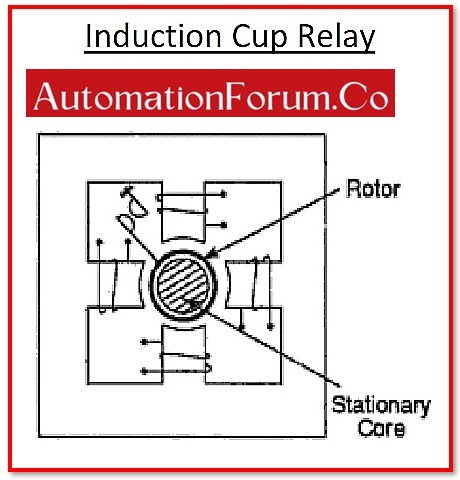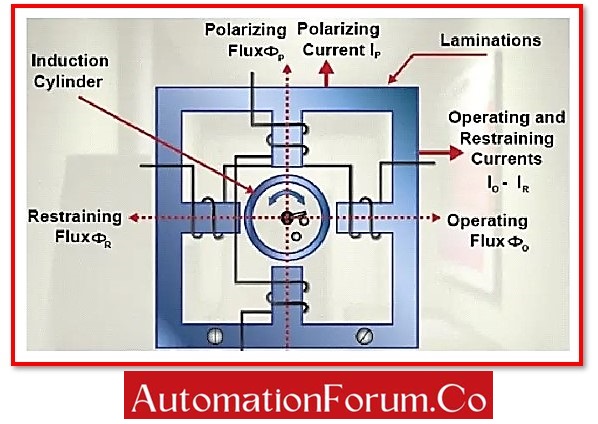Induction Cup Relay:
Induction cup relay is one type of induction disc relay. Induction disc relays and induction cup relays both operate on the same principles. This relay’s basic design is similar to that of a four- or eight-pole induction motor. The protective relay’s pole count is determined by the number of accommodating windings.
Construction of Induction Cup Relay:

An induction cup relay is built similarly to an induction motor. The following elements make up the induction cup relay:
1. Stationary iron core – stator,
2. Hollow cylindrical cup – rotor,
3. Electromagnet, and
4. Coils.

1. Stationary iron core:
The stationary iron core performs the function of a stator, which has two, four, or more poles. Typically, it is built to accommodate 4 or more poles.
2. Hollow cylindrical cup:
Similar to a disc relay, the hollow cylindrical cup functions as a rotor. In the space between the stationary iron core and the electromagnets, it can freely rotate.
3. Electromagnet:
Magnetic fields are created by electromagnets. It consists of two pairs of coils, which produce flux when they are powered. Even if they are separated from one another by an angle, these fluxes will have the same frequency.
4. Coils:
Coils will energise the iron core, creating a revolving flux in the air gap.
Working of Induction Cup Relay:
Eddy currents are created to flow in the rotor as a result of fluxes energised by coil. As a result, a force that affects the rotor will be created. As the induction motor’s rotor, the hollow cup revolves in the direction of the magnetic field created by the magnets and the stationary iron core.

As a result, the trip circuit’s fixed contacts close and the breaker receives a trip signal to open the circuit. To prevent the rotor from rotating constantly, a control spring backstop is attached to the cup’s spindle.
Advantages of Induction Cup Relay:
1. The torque to weight ratio of induction cup relays is extremely high.
2. A more effective magnetic system results in less magnetic leakage in the induction cup relay.
3. Because of the light rotor, they operate very quickly; the working duration is less than 0.10 seconds.
4. Induction cup relays are extremely sensitive relays.
5. Induction cup relays produce constant, vibration-free torques.
Disadvantages of Induction Cup Relay:
Induction cup relays are intrinsically less sensitive to DC transients. Additionally, it is sensitive to transients when compared to disc relay.
Application of Induction Cup Relay:
1. Directional and distance relays in transmission and distribution lines use induction cup relays.
2. Induction cup relays work best for protection in situations where normal and abnormal circumstances are barely different.





